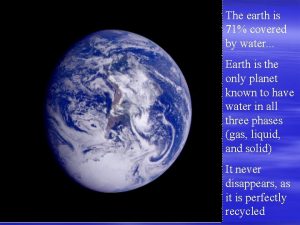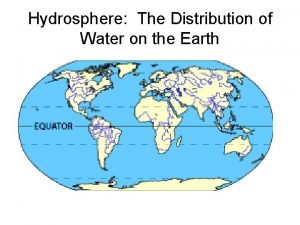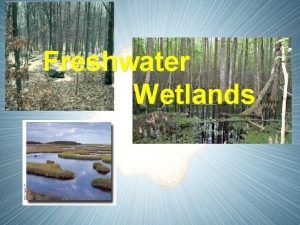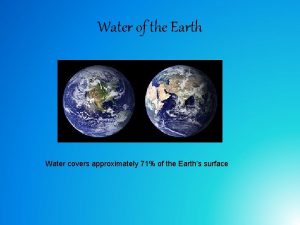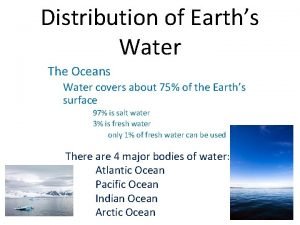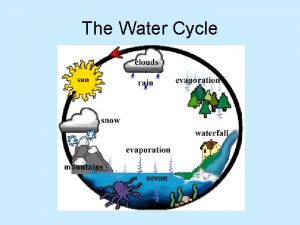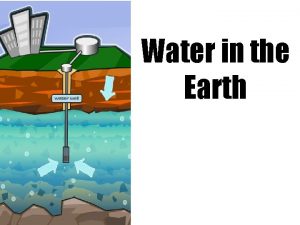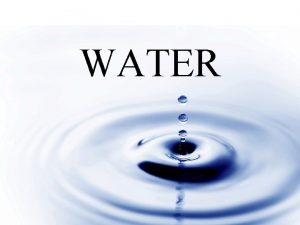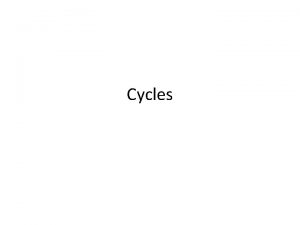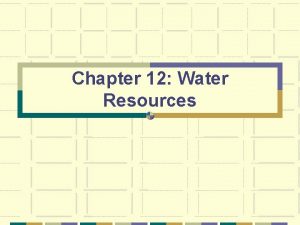The Water Cycle Water on Earth Water covers

















- Slides: 17

The Water Cycle

Water on Earth Water covers nearly 71 percent of Earth's surface.

Water on Earth Most of Earth's water—roughly 97 percent—is salt water that is found in the oceans.

Water on Earth Only 3 percent is fresh water. About 2% of that is found in the huge masses of ice near the North and South Poles.

Water on Earth About 0. 1% more is found in the atmosphere. Most water in the atmosphere is invisible water vapor, the gaseous form of water. This includes clouds

Water on Earth Less than 1 percent of the water on Earth is fresh water that is available for humans to use


Water on Earth On Earth, we find water in: Oceans Ice Rivers and Lakes Below Earth's Surface Water that fills the cracks and spaces in underground soil and rock layers is called groundwater. Far more fresh water is located underground than in all Earth's rivers and lakes.

The Water Cycle Water is naturally recycled through the water cycle. The water cycle is the continuous process by which water moves through the living and nonliving parts of the environment. The sun is the source of energy that drives the water cycle In the water cycle, water moves from bodies of water, land, and living things on Earth's surface to the atmosphere and back to Earth's surface.

The Water Cycle Steps of the Water Cycle Water Evaporates Clouds Form - Condensation Water Falls as Precipitation Accumulation -Water collects on the surface and underground And then it starts all over again!

Water Evaporates Evaporation is the process by which liquid water absorbs enough energy to change to a gas. Ocean Lakes Soil, puddles, and even from your skin Plants Eventually the water is given off through the leaves as water vapor in a process called transpiration

Clouds Form – Condensation Water molecules find their way into the atmosphere, warm air carries them upward. Higher up, air tends to become much colder. Cold air holds less water vapor than warm air. Some of the water vapor cools and condenses into liquid water. Condensed droplets of water clump together around dust in the air, forming clouds

Water Falls as Precipitation As more water vapor condenses, water droplets in a cloud eventually become so heavy that they fall back to Earth. Water that falls to Earth as rain, snow, hail, or sleet is called precipitation Most precipitation falls directly into the oceans Precipitation is the source of all fresh water on and below Earth's surface. The water cycle renews the usable supply of fresh water on Earth.

Collection: Underground and on Earth’s Surface Collection Rivers/streams, lakes, and the ocean Underground Water Runoff, water flowing downward on the surface, absorbs into the ground as groundwater This is how we get water from wells! It eventually flows into a body of water



 How much water covers the earth
How much water covers the earth Water covers earth surface
Water covers earth surface An ecosystem in which water either covers the soil
An ecosystem in which water either covers the soil Water covers approximately
Water covers approximately Water covers about
Water covers about Water and water and water water
Water and water and water water How is the carbon cycle similar to the water cycle brainpop
How is the carbon cycle similar to the water cycle brainpop Water cycle the hydrologic cycle
Water cycle the hydrologic cycle Hát kết hợp bộ gõ cơ thể
Hát kết hợp bộ gõ cơ thể Lp html
Lp html Bổ thể
Bổ thể Tỉ lệ cơ thể trẻ em
Tỉ lệ cơ thể trẻ em Chó sói
Chó sói Tư thế worm breton là gì
Tư thế worm breton là gì Chúa yêu trần thế alleluia
Chúa yêu trần thế alleluia Các môn thể thao bắt đầu bằng tiếng nhảy
Các môn thể thao bắt đầu bằng tiếng nhảy Thế nào là hệ số cao nhất
Thế nào là hệ số cao nhất Các châu lục và đại dương trên thế giới
Các châu lục và đại dương trên thế giới
